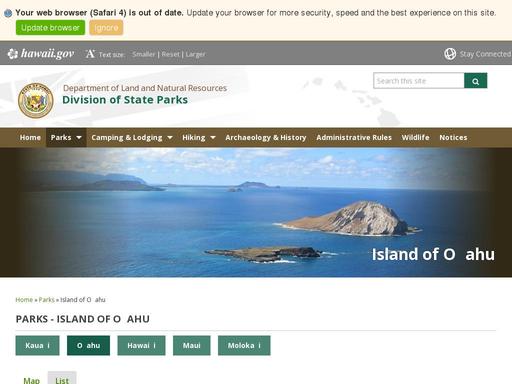Rate Ahupua a O Kahana State Park
Aloha and Welcome to Hawaii’s State Parks!
Hawaii is the most remote land mass on earth. Its reputation for unsurpassed natural beauty is reflected in its parks. Hawaii’s state park system is comprised of 51 state parks encompassing nearly 30,000 acres on the 5 major islands. The park environments range from landscaped grounds with developed facilities to wildland areas with trails and primitive facilities.
Outdoor recreation consists of a diversity of coastal and wildland recreational experiences, including picnicking, camping, lodging, ocean recreation, sightseeing, hiking, and pleasure walking. The park program protects, preserves, and interprets excellent examples of Hawaii’s natural and cultural history. The exceptional scenic areas are managed for their aesthetic values and developed for their superb views.
We invite you to experience Hawaii, learn about its unique resources and history, and participate in outdoor recreation by visiting our parks. As you visit, please help us protect Hawaii’s fragile and irreplaceable resources for future generations
About this location:
State Park
Hours
Daily During Daylight Hours
Beach Area:
April 1 to Labor Day:
7 am to 7:45 pm
After Labor Day to March 31:
7 am to 6:45 pm
Coconut grove area:
Open Daily 7 am to 6:45 pm
Entrance Fee
- None
About
Ahupuaʻa ʻO Kahana State Park is located on the windward side of O’ahu, between Kane’ohe and Laʻie, and 26 miles from Honolulu. Kahana is a relatively unspoiled valley, and one of only a few publicly owned ahupuaʻa, or ancient Hawaiian land division, in the state.
An ahupuaʻa includes lands from the mountains to the sea (mauka-makai), encompassing all of the resource zones needed for subsistence. The ahupuaʻa of Kahana encompasses almost 5,300 acres, ranging from sea level at Kahana Bay to 2,670 feet at Puʻu Pauao on the crest of the Koʻolau mountains. Kahana is one of the wettest valleys on Oʻahu. Overcast skies and showers are frequent, with an average annual rainfall of 75″ along the coast to 300″ at the back of the valley. Temperatures can range from the mid-60s to the mid-80s.
Cultural Background
Kahana was a thriving fishing and farming community prior to Western contact. Those living in Kahana had an abundance of fresh water and fertile soil on the valley floor to cultivate kalo (taro), the staple crop. The loʻi (ponded fields of kalo) were irrigated by ʻauwai (ditches) that diverted water from the streams to the fields. Kahana Bay provided a wealth of fish and shellfish.
In the 19th Century, following the unification of the Hawaiian Islands by Kamehameha I, the population rapidly declined as a result of Western contact and the introduction of foreign diseases. Sugar cane cultivation and the use of the valley as a WWII jungle warfare training site, have altered the natural and cultural environment of Kahana.
The Living Park
The primary purpose of this park is to nurture and foster native Hawaiian cultural traditions and the cultural landscape of rural windward Oʻahu. Established as a “living park”, there are thirty-one families living in the ahupuaʻa of Kahana. These families assist with interpretive programs that share the Hawaiian values and lifestyle. If you have a group interested in a cultural program at the park, please call 237-7767.
Archaeology
There are extensive remnants of Hawaiian culture in the valley, including a heiau (religious temple), koʻa (fishing shrines), fishponds, house sites, stone-walled enclosures, ʻauwai (irrigation channels), agricultural terraces, walls and planting areas. While many of these sites are inaccessible to the public, Kapa’ele’ele Koʻa and Keaniani Kilo (lookout) are accessible via a trail on the west side of the valley mouth. From the kilo, the kilo iʻa, or fish watcher, spied schools of akule in the bay and signaled to valley residents who would collectively net them. Huilua Fishpond, the most impressive site in the valley, and presently under restoration, can be visited from the east side of the bay.
Trails
There are two hiking trails available to the public. Both are relatively easy walking, but trails may be muddy. No permits are required and detailed trail maps are available at the Orientation Center.
Kapa’ele’ele Ko’a and Keaniani Lookout Trail is a one mile long loop trail that begins at the Orientation Center and takes about one hour. The trail passes two cultural sites and offers stunning views of Kahana Bay.
Nakoa Trail is named for the koa trees found along this 2.5 mile loop trail through a tropical rain forest. The loop hike takes about 2 hours. The total length of the hike is 5 miles from the Orientation Center. The trailhead can be reached by following the main road up the valley. This trail crosses Kahana Stream twice. Fruit picking when in season.
Activities
- Beachgoing
- Camping
- Dogs on Leash
- Fishing
- Hiking
- Hunting
- Sightseeing
Facilities
- Boat Ramp
- Campsites
- Picnic table
- Restroom
- Showers
- Trash Cans
- Water Fountain
Camping
There are ten (10) beach campsites in the park. Camping is by permit only.
Fees start at $12 per campsite per night.
Prohibited
- No Motorized Vehicles/ATV’s
- No Alcoholic Beverages
- No Open Fires
- No Smoking
- No Commercial Activities






